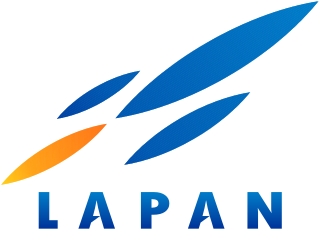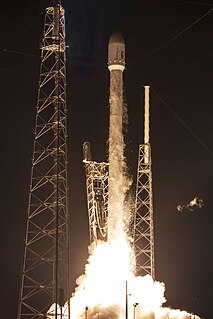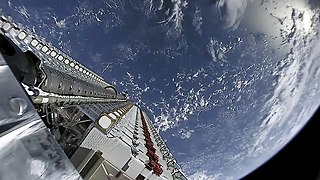Related Research Articles

A low Earth orbit (LEO) is an Earth-centered orbit near the planet, often specified as having a period of 128 minutes or less and an eccentricity less than 0.25. Most of the artificial objects in outer space are in LEO, with an altitude never more than about one-third of the radius of Earth.

The geography of Malta is dominated by water. Malta is an archipelago of coralline limestone, located in the Mediterranean Sea, 81 kilometres south of Sicily, Italy, and nearly 300 km north (Libya) and northeast (Tunisia) of Africa. Although Malta is situated in Southern Europe, it is located farther south than Tunis, capital of Tunisia, Algiers, capital of Algeria, Tangier in Morocco and also Aleppo in Syria, and Mosul in Iraq in the Middle East. Only the three largest islands – Malta, Gozo and Comino – are inhabited. Other (uninhabited) islands are: Cominotto, Filfla and the St.Paul's Islands. The country is approximately 316 km2 in area. Numerous bays along the indented coastline of the islands provide harbours. The landscape of the islands is characterised by high hills with terraced fields. The highest point, at 253 metres, Ta' Zuta on mainland Malta. The capital is Valletta.

Sputnik 2, or Prosteyshiy Sputnik 2 was the second spacecraft launched into Earth orbit, on 3 November 1957, and the first to carry a living animal, a Soviet space dog named Laika. Laika died on the fourth orbit due to overheating caused by an air conditioning malfunction.

Himalia, or Jupiter VI, is the largest irregular satellite of Jupiter, with a diameter of at least 140 km (90 mi). It is the sixth largest Jovian satellite, after the four Galilean moons and Amalthea. It was discovered by Charles Dillon Perrine at the Lick Observatory on 3 December 1904 and is named after the nymph Himalia, who bore three sons of Zeus. It is one of the largest planetary moons in the Solar System not imaged in detail, and the third largest not imaged in detail within the orbit of Neptune.
A geocentric orbit or Earth orbit involves any object orbiting Earth, such as the Moon or artificial satellites. In 1997, NASA estimated there were approximately 2,465 artificial satellite payloads orbiting Earth and 6,216 pieces of space debris as tracked by the Goddard Space Flight Center. More than 16,291 objects previously launched have undergone orbital decay and entered Earth's atmosphere.

Explorer 32, also known as Atmosphere Explorer-B (AE-B), was a NASA satellite launched by the United States to study the Earth's upper atmosphere. It was launched from Cape Canaveral on a Delta C1 launch vehicle, on 25 May 1966. It was the second of five "Atmosphere Explorer", the first being Explorer 17. Though it was placed in a higher-than-expected orbit by a malfunctioning second stage on its launch vehicle, Explorer 32 returned data for ten months before failing due to a sudden depressurization. The satellite reentered the Earth's atmosphere on 22 February 1985.
Space launch vehicle Shtil' (Russian: , is a converted SLBM used for launching artificial satellites into orbit. It is based on the R-29RM designed by State Rocket Center Makeyev and related to the Volna Launch Vehicle. The Shtil' is a 3-stage launch vehicle that uses liquid propellant. It is the first launch vehicle to successfully launch a payload into orbit from a submarine, although launch from land based structures is possible as well.
Vulture Glacier is located in Banff National Park, Alberta, Canada, northwest of Lake Louise, and can be viewed from the Icefields Parkway. Vulture Glacier is an outflow glacier from the Wapta Icefield, which rests along the Continental Divide. The glacier had an area of 4.9 km2 (1.9 mi2) in the 1980s, however, all of the glaciers in the Canadian Rockies have been retreating steadily since the middle of the 19th century.

Crowfoot Glacier is located in Banff National Park, Alberta, Canada, 32 km (20 mi) northwest of Lake Louise, and can be viewed from the Icefields Parkway. The glacier is situated on the northeastern flank of Crowfoot Mountain.

National Institute of Aeronautics and Space was the Indonesian government space agency. It was established on November 27, 1963, by former Indonesian president Sukarno after one year's existence of an informal space agency organization. LAPAN is responsible for long-term civilian and military aerospace research.
Oceansat-1 or IRS-P4 was the first Indian satellite built primarily for ocean applications. It was a part of the Indian Remote Sensing Programme satellite series. The satellite carried an Ocean Colour Monitor (OCM) and a Multi-frequency Scanning Microwave Radiometer (MSMR) for oceanographic studies. Oceansat-1 thus vastly augment the IRS satellite system of Indian Space Research Organisation (ISRO) comprising four satellites, IRS-1B, IRS-1C, IRS-P3 and IRS-1D and extend remote sensing applications to several newer areas.

AsiaSat 6 / Thaicom 7 is a geostationary communications satellite which is operated by the Asia Satellite Telecommunications Company (AsiaSat) and was launched into orbit on 7 September 2014. The satellite project was developed in cooperation between satellite operators AsiaSat and Thaicom. AsiaSat owns half of the satellite's 28 transponders which are marketed as AsiaSat 6. The other half of the satellite is owned by Thaicom and is marketed as Thaicom 7. AsiaSat's part of the satellite is operated under license of the China (PRC), whereas Thaicom's part is operated under license of Thailand.
Intelsat III F-2 was a communications satellite operated by Intelsat. Launched in 1968 it was operated in geostationary orbit at a longitude of 24 degrees west for around eighteen months.

AsiaSat 8 then AMOS-7 is a Hong Kong-turned-Israeli geostationary communications satellite which is operated by the Asia Satellite Telecommunications Company (Asiasat).

Starlink is a satellite internet constellation operated by SpaceX providing satellite Internet access coverage to most of the Earth. The constellation has grown to over 1,700 satellites through 2021, and will eventually consist of many thousands of mass-produced small satellites in low Earth orbit (LEO), which communicate with designated ground transceivers. While the technical possibility of satellite internet service covers most of the global population, actual service can be delivered only in countries that have licensed SpaceX to provide service within any specific national jurisdiction. As of January 2022, the beta service offering is available in 24 countries.
PSLV-C2 was the second operational launch and overall fifth mission of the Polar Satellite Launch Vehicle (PSLV) program. This launch was also the forty-third launch by Indian Space Research Organisation (ISRO) since its first mission on 1 January 1962. The vehicle carried three satellites which were deployed in the Sun-synchronous low Earth orbit. The vehicle carried India's first remote sensing satellite Oceansat-1 (IRS-P4) as the main payload. It also carried South Korean satellite KITSAT-3 and German satellite DLR-Tubsat as auxiliary payloads. PSLV-C2 was the first Indian Expendable launch vehicle to carry and deploy more than one satellite in a mission. This was also India's and ISRO's first commercial spaceflight where South Korea and Germany each paid US$1.0 million to ISRO for launching their satellites.
DLR-Tubsat was a German remote sensing microsatellite, developed in a joint venture between Technical University of Berlin (TUB) and German Aerospace Center (DLR). TUB was responsible for the satellite bus and DLR was responsible for the payload. The satellite was launched into orbit on 26 May 1999, on the fifth mission of the PSLV program PSLV-C2. The launch took place in the Sriharikota Launching Range. The satellite had an expected life of one year.
There have been a number of ventures into submarine-launched satellites. The advantage of launching a satellite from a submarine compared to from land is that the launch vehicle can reach a large number of different inclinations and could increase its performance to low Earth orbit by launching from equatorial sites. Missiles used for this purpose include the Volna and the Shtil', as well as theoretically the R-39 Rif. Submarines used include Delta-class submarines.
S-Net is a worldwide inter-satellite communications network consisting of four satellites and being operated by the Technical University of Berlin.
The German space programme is the set of projects funded by the government of Germany for the exploration and utilisation of outer space. The space programme is run by the German Aerospace Center, who conduct research, plan, and implement the programme on behalf of the German federal government.
References
- Encyclopedia astronautica (http://astronautix.com)